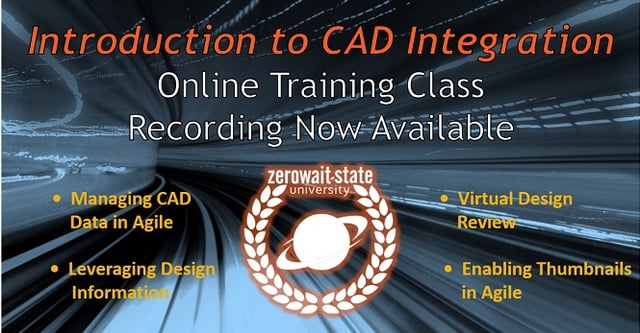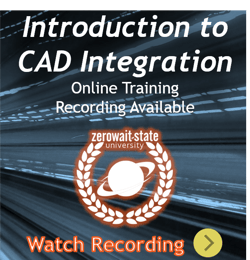 We have been reviewing Product Lifecycle Management (PLM) success factors as part of an attempt to improve the value propositions of our clients, and training continues to emerge as a key theme. Typical training experiences for clients have been mostly ad hoc mentoring or “train the trainer” type efforts where key power users are provided instruction that they can then pass on to the rest of the organization. It is surprising how much money is spent on PLM software and services versus how much companies are willing to spend on training. PLM vendors and partners (including us) tend to go along with this not wanting to rock the boat or jeopardize sales. As a vendor, if you make a big deal about training, customers will start to question whether your system is easy to use and wonder if perhaps it is overly complex…and start looking around for something easier. Ironically, this creates a self-created outcome around adoption and productivity since any new system – no matter how intuitive – will require some instruction to be successfully deployed. This article will review the statistics around training, the challenges around delivering it effectively and the results if you can successfully execute on effective training.
We have been reviewing Product Lifecycle Management (PLM) success factors as part of an attempt to improve the value propositions of our clients, and training continues to emerge as a key theme. Typical training experiences for clients have been mostly ad hoc mentoring or “train the trainer” type efforts where key power users are provided instruction that they can then pass on to the rest of the organization. It is surprising how much money is spent on PLM software and services versus how much companies are willing to spend on training. PLM vendors and partners (including us) tend to go along with this not wanting to rock the boat or jeopardize sales. As a vendor, if you make a big deal about training, customers will start to question whether your system is easy to use and wonder if perhaps it is overly complex…and start looking around for something easier. Ironically, this creates a self-created outcome around adoption and productivity since any new system – no matter how intuitive – will require some instruction to be successfully deployed. This article will review the statistics around training, the challenges around delivering it effectively and the results if you can successfully execute on effective training.
As I was researching this article, I came across an excellent webinar by Cimdata titled “Training Best Practices for Solution Provider Education” from last December. The presentation given by Chris Gregory from Cimdata really made my job easy since it captured all the points I wanted to make and confirmed some thoughts I had on the topic. It also highlighted some shortcomings in our current service offerings and reinforced feedback we have received from some of our clients. We will be addressing these shortcomings by investing heavily in training content for our clients and we expect this will be of great benefit to them and us. The presentation has its own agenda for Cimdata, but I think we can glean several important facts from the information presented by Mr. Gregory. The first key point is that PLM customers do not invest enough money in training. He actually cites an article I wrote titled “The PLM State: Training Day- PLM’s Most Overlooked Need”. Unfortunately the link is broken in his presentation but I found it with a quick Google search here. I had found an article that broke down the spending percentages and training was listed as 5% of the initial cost of PLM, which was one of the lowest percentages of any category. Turnabout is fair play since I went on to quote an ebook in my article (that I suspect Mr. Gregory might have had a hand in while he was at PTC) that quantified the value of training at a 5-10x factor in regards to PLM benefits realized, versus companies who did not emphasize training as part of their PLM deployment.
The Cimdata presentation goes on to highlight some of the shortcomings in vendor-provided training. The first problem is that training tends to focus on the technology and not the process. This makes sense when you consider that in most cases, PLM vendor’s experience is really around their platform and not necessarily around industry best practices. Sometimes trainers will have some industry experience but the author of the training material rarely has this knowledge and I don’t recall seeing a vendor-produced training curriculum that had this type of focus. It is also very difficult to produce this type of curriculum since industries and companies vary greatly, so best practices can run a broad gamut and are difficult to capture in training materials. He also points out that the most experienced people working for PLM vendors and solution providers tend to be on the demand generation side since this is where they can be most leveraged by their employers. Vendors and consultants loathe using their strongest resources on training. Another issue pointed out in the presentation is that custom training can be prohibitively expensive and may not produce the best outcomes. He cites a number in the presentation that claims the average cost for one hour of training development is $1800. I wish that were true, at least from a financial perspective, but it can typically be about 1:1 to the actual instructor time. The net result from all this is that companies do not spend enough on training and the training delivered is not sufficient to support the desired outcomes from PLM deployment.
Based on our experience, we agree with this assessment. The best practices cited in the presentation are to build a training plan just like you build a project plan for PLM (you do have one of those, right?). Developing outcomes for training and a way to validate that you have achieved them is important to success. They also suggest making sure the trainers have sufficient industry experience to deliver the training material effectively. Being able to weave in real world examples is invaluable when it comes to getting points across in training. Beyond that, as I mentioned in my previous article making sure that training is an ongoing activity and not a singular event, will ensure that your investment in PLM provides maximum yield. What we have determined is that as a solutions provider, we have mimicked our clients and under invested in our training programs. We will be upgrading the training materials we provide to our clients and make sure that the material is relative to their roles in the organizations. While it is tempting to try and rely on power users in these companies, we have found that these key resources are often oversubscribed themselves and do not have the bandwidth to dispense with training, and it needs to be scheduled as part of the project. We will be developing broader curriculums that we will share on the web as introductory training classes for various PLM disciplines, and then using these frameworks to create deeper curriculums for specific clients. I suspect this will result in higher quality training for our customers and better outcomes for their PLM investment.
Our first online training program, Integrating Mechanical Design into PLM, just launched this week and we’ve opened registration for the first class, Introduction to CAD Integration, at NO COST. Seating is limited to make sure all students have access to our expert trainers. Don’t miss this opportunity!



